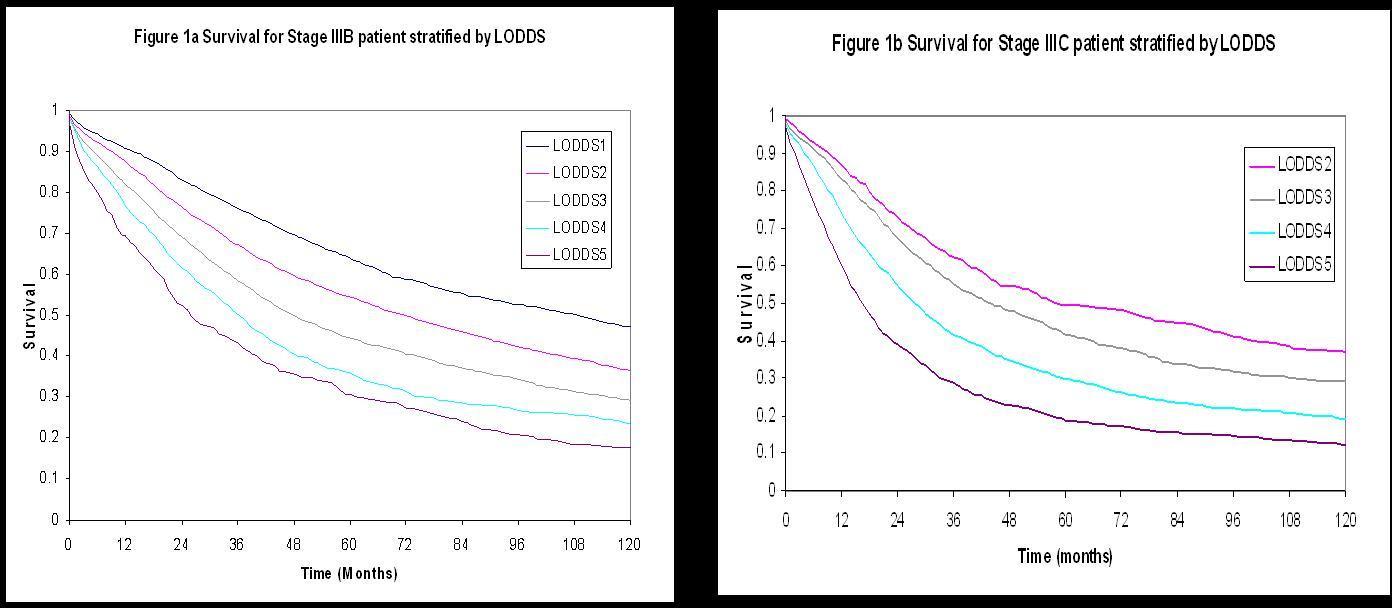Back to 2008 Program and Abstracts
Background: Recent literature has shown that lymph node ratio (LNR) and log of odds (LODDS) of positive lymph nodes (LN) can equally predict prognosis in patients with breast cancer. We hypothesize that in patients with stage III colon cancer, LODDS is even superior to LNR.
Methods: 24,477 stage III colon cancer cases from SEER are included. Based on LNR, patients are categorized into four groups, LNR1 to 4, according to cutoff points 1/14, 0.25 and 0.50 and on LODDS, patient are divided into five groups, LODDS 1 to 5, according to cutoff points -2.2, -1.1, 0 and 1.1. Kaplan-Meier and Cox proportional hazard model were used to evaluate the prognostic effect and estimate the relative risk (RR) and 95% confidence interval (CI).
Results: In stage III colon cancer, both LNR and LODDS are in agreement in staging patients except LNR4. When stratify LNR4 into LODDS4 and LODDS5, patients have significant different 5-year survival (33.5% vs. 23.3%, p<0.0001). The observed 5-year survival for stage IIIB patients classified as LODDS1 to LODDS5 is 63.7%, 54.4%, 44.4%, 35.8% and 30.6% respectively (p<0.0001). On the other hand, the observed 5-year survival for patients with stage IIIC diseases who are classified as LODDS2 to LODDS5 is 49.7%, 41.7%, 29.8% and 18.8% respectively (p<0.0001). Univariate analysis shows that LODDS, LNR, age, race, number of negative LN (NNLN) or total number of LN examined (TNLN), tumor grade, size, and number of positive LN are significantly associated with survival. Whereas, in the multivariate Cox model, NNLN or TNLN, and LNR are not independently associated with survival after adjusting for LODDS.
Conclusion: Patients with stage IIIB and IIIC colon cancer represent a heterogeneous group of patients with the majority either over-staged or under-staged. Patients with LNR4 also represent a heterogeneous group. In patients with stage III colon cancer, LODDS is a more accurate prognostic method than AJCC N staging, NNLN, and TNLN.
Multivariate Cox model
| Variables | Age | Race | Tumor Grade | Tumor Size | TNLN | NPLN | LNR | LODDS |
| P-value | <0.0001 | <0.0001 | <0.0001 | <0.0001 | 0.54 | <0.0001 | 0.52 | <0.0001 |
| Risk Ratio | 1.04 | 1.24 | 1.16 | 1.003 | 1.001 | 1.04 | 0.90 | 1.28 |
| 95% CI | 1.037-1.040 | 1.19-1.30 | 1.12-1.21 | 1.002-1.003 | 0.997-1.005 | 1.03-1.05 | 0.65-1.24 | 1.19-1.39 |

 500 Cummings Center
500 Cummings Center +1 978-927-8330
+1 978-927-8330
 +1 978-524-0461
+1 978-524-0461